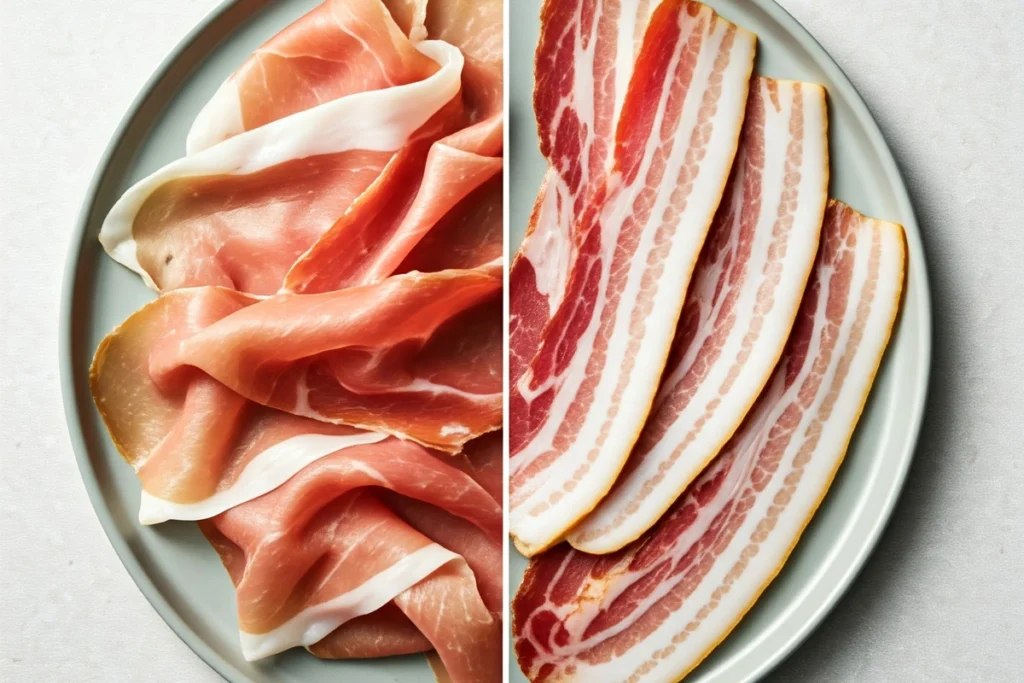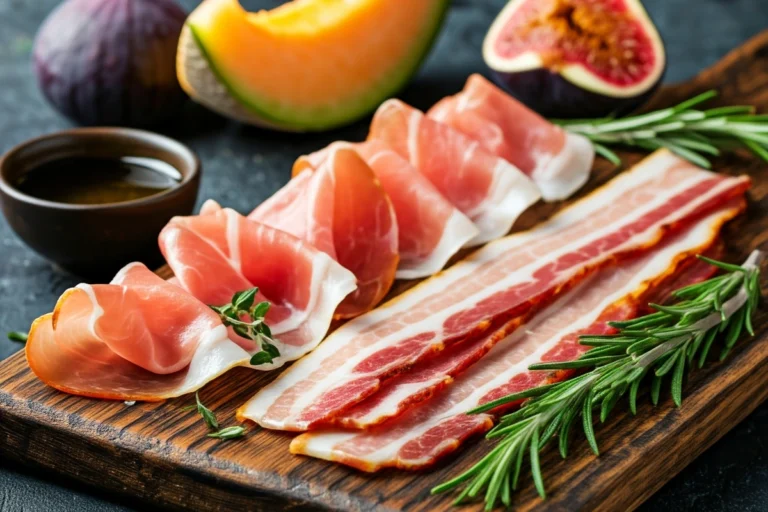When it comes to choosing between prosciutto and bacon, health-conscious eaters often find themselves in a pickle. Both are cured meats, loved for their unique flavors and versatility in the kitchen. But which one is the healthier option? This article dives deep into the nutritional profiles, health benefits, risks, and cultural significance of these two popular meats. By the end, you’ll have a clearer understanding of whether prosciutto truly holds the crown for being the healthier choice.
Introduction to Prosciutto and Bacon
What Is Prosciutto?
Prosciutto, an Italian delicacy, is a dry-cured ham that’s thinly sliced and often served uncooked (known as prosciutto crudo). Originating from regions like Parma and San Daniele, it’s made through a meticulous curing process that uses just salt and time to preserve the meat. With its delicate, savory flavor and melt-in-your-mouth texture, prosciutto is a staple in Mediterranean diets.
What Is Bacon?
Bacon, a favorite in Western cuisine, comes from pork belly or back cuts. It’s typically cured, smoked, and often cooked until crispy. Known for its smoky, salty flavor, bacon is a versatile ingredient in breakfasts, sandwiches, and savory dishes. While delicious, bacon’s reputation has taken a hit due to concerns over its high fat and sodium content.
Why Compare Prosciutto and Bacon?
At first glance, prosciutto and bacon seem similar—they’re both cured meats made from pork. However, their nutritional profiles and preparation methods set them apart. This comparison is vital for understanding which option aligns better with a healthy lifestyle. By exploring their health benefits, risks, and alternatives, you can make an informed choice about incorporating them into your diet.
Nutritional Comparison of Prosciutto and Bacon
Caloric Content: How Do They Stack Up?
When comparing prosciutto and bacon, the first noticeable difference lies in their caloric content. A 1-ounce serving of prosciutto typically contains around 70 calories, while the same amount of bacon can reach 130-150 calories, depending on the brand and preparation method. This makes prosciutto a lighter option for those watching their calorie intake.
Macronutrient Profiles (Protein, Fats, and Carbs)
Both prosciutto and bacon are primarily composed of protein and fat, but the ratios vary. Prosciutto offers a moderate amount of protein with lower fat content compared to bacon, which is often high in saturated fats. Bacon, being a richer source of fats, contributes to a creamy, crispy texture but may not align well with low-fat diets. Interestingly, neither meat contains carbohydrates, making them suitable for low-carb or ketogenic diets.
Micronutrients and Sodium Levels
Micronutrient content is another area where prosciutto holds an edge. Prosciutto delivers small amounts of essential vitamins and minerals such as B vitamins, iron, and zinc. However, it’s crucial to note that both meats are high in sodium, with bacon typically exceeding prosciutto due to added curing agents. Consuming either in moderation is key to maintaining heart health.

For detailed nutritional breakdowns of prosciutto and bacon, explore GoldyRecipe’s guide to prosciutto.
Health Benefits of Prosciutto
Nutritional Value of Prosciutto
Prosciutto stands out for its simple curing process, which avoids heavy processing and additives. Unlike bacon, prosciutto isn’t smoked or treated with artificial sweeteners. This minimal intervention preserves the natural nutrients of the pork, offering a purer protein source.
Is Prosciutto Considered a Healthier Option?
Yes, especially for those focused on leaner cuts of meat. Prosciutto’s lower fat content makes it an appealing choice for individuals aiming to manage cholesterol levels. Additionally, its lower calorie count per serving is a bonus for weight-conscious eaters.
Role of Prosciutto in a Balanced Diet
Due to its robust flavor, a small portion of prosciutto can enhance meals without overwhelming calorie counts. Paired with fruits like melon or wrapped around vegetables like asparagus, prosciutto can become part of a nutrient-dense and heart-friendly diet. For more ideas, see this prosciutto-focused healthy recipe.
Health Risks of Bacon Consumption
Why Is Bacon Often Considered Unhealthy?
Bacon is undeniably delicious, but its high fat and sodium content has led to concerns about its impact on health. A typical serving of bacon contains saturated fats that can raise LDL cholesterol levels, a key risk factor for heart disease. Furthermore, bacon’s sodium levels are significantly high due to curing agents like salt and nitrates, which can contribute to hypertension if consumed excessively.
Saturated Fats and Their Impact on Health
Saturated fats in bacon, while providing its rich flavor, may pose a challenge for those managing cholesterol or weight. Over time, diets high in saturated fats are linked to increased risks of cardiovascular diseases. While enjoying bacon occasionally is fine, regular consumption could tip the balance towards negative health outcomes.
Sodium and Preservatives in Bacon
Another major concern with bacon is its preservative content, including nitrates and nitrites. These compounds are used to enhance flavor and color but can form nitrosamines, potentially harmful chemicals, when cooked at high temperatures. To make healthier choices, consider nitrate-free or low-sodium bacon varieties.
For more insights on healthier food choices, check out GoldyRecipe’s guide to food alternatives.
Processing and Additives in Prosciutto vs. Bacon
How Is Prosciutto Made? The Curing Process
Prosciutto is crafted through a time-honored process involving just two ingredients: pork and salt. The curing period, which can last up to two years, allows the meat to develop its signature flavor and texture naturally. Without smoking or artificial additives, prosciutto retains its purity, making it a healthier choice compared to heavily processed meats.
How Is Bacon Made? Smoking and Processing
Unlike prosciutto, bacon undergoes additional steps, including smoking, curing with salts, and often adding sweeteners like brown sugar or maple syrup. While these methods enhance bacon’s flavor, they also increase its calorie and preservative content. The presence of additives like nitrates in bacon further distinguishes it from prosciutto’s cleaner profile.
Differences in Additives and Preservatives
When answering the question, “Is prosciutto healthier than bacon?”, the minimal use of additives in prosciutto gives it a clear advantage. Bacon’s heavy reliance on preservatives not only impacts its nutritional value but also raises concerns over long-term health risks. For those looking for a less processed meat option, prosciutto emerges as the better choice.
For more recipe inspiration or to explore ways to include prosciutto in your meals, consider browsing GoldyRecipe’s prosciutto guide.
Cultural and Culinary Uses of Prosciutto and Bacon
Traditional Uses of Prosciutto in Italian Cuisine
Prosciutto, a hallmark of Italian culinary tradition, has graced charcuterie boards, pastas, and pizzas for centuries. Its delicate flavor pairs beautifully with fruits like melon or figs, creating a perfect balance of sweet and savory. Italians often use prosciutto to wrap asparagus or stuff chicken breasts, enhancing meals with a rich yet subtle taste.
Bacon’s Role in Western Diets
Bacon has a more robust role in Western diets, dominating breakfast tables and comfort food dishes. From crispy strips alongside eggs to its use in sandwiches and burgers, bacon’s smoky, salty flavor is a favorite. Additionally, creative spins like candied bacon or bacon-wrapped jalapeños highlight its versatility. However, when asking “Is prosciutto healthier than bacon?”, prosciutto’s lighter preparation methods often win favor for those seeking a health-conscious choice.
Healthier Cooking Methods for Both Meats
While both meats have their indulgent applications, cooking methods can make a big difference. Baking bacon on a rack can reduce grease, while prosciutto, usually served uncooked, keeps calories low. Incorporating these meats into dishes thoughtfully can balance their flavors and health impacts.

Are There Healthier Alternatives?
Low-Sodium or Nitrate-Free Bacon Options
For bacon lovers who want to cut back on preservatives, nitrate-free or low-sodium options offer a healthier alternative. These versions reduce exposure to harmful compounds while retaining bacon’s signature flavor. Opting for center-cut bacon, which is leaner, can also help lower fat intake.
Lean Prosciutto Cuts
Prosciutto naturally has fewer additives, but choosing leaner cuts ensures lower fat content. Authentic Italian prosciutto, made with just salt, is a standout choice for those looking to avoid processed foods. Its mild flavor and lower calorie count make it a versatile and healthier option for various dishes.
Plant-Based Substitutes for Prosciutto and Bacon
For plant-based eaters, there are numerous meatless alternatives. Coconut or tempeh bacon offers a smoky flavor without the health risks of saturated fats and sodium. Meanwhile, marinated eggplant or mushroom slices can mimic the texture and taste of prosciutto.
For more ideas on how to use prosciutto or find alternative recipes, explore GoldyRecipe’s prosciutto guide.
Expert Opinions and Dietary Recommendations
What Do Nutritionists Say About Prosciutto?
Many nutritionists agree that prosciutto can be a healthier choice compared to heavily processed meats like bacon. Thanks to its lower fat content and minimal additives, prosciutto aligns well with balanced diets, particularly when consumed in moderation. Experts often emphasize its compatibility with the Mediterranean diet, which is renowned for heart health benefits. However, even prosciutto’s sodium levels mean it should be enjoyed sparingly.
Bacon in Moderation: Expert Advice
Dieticians caution against frequent bacon consumption due to its high levels of saturated fat and preservatives. While bacon can be part of a meal occasionally, incorporating nitrate-free or reduced-sodium options is recommended. Pairing bacon with nutrient-rich sides, like leafy greens, can help balance its nutritional impact. Still, when asked, “Is prosciutto healthier than bacon?”, experts often point to prosciutto’s cleaner profile as a better option.
Incorporating Either Meat in a Healthy Lifestyle
Both meats can be included in a healthy lifestyle with mindful choices. Opting for smaller portions and pairing with whole, unprocessed foods like fruits, vegetables, or whole grains can help mitigate potential health risks. Substituting prosciutto for bacon in recipes is a simple way to reduce fat and calorie intake while retaining robust flavors.
FAQs About Prosciutto and Bacon
What Are the Key Differences Between Prosciutto and Bacon?
Prosciutto and bacon differ primarily in their preparation and nutritional profiles. Prosciutto is a dry-cured ham made with just salt, while bacon is smoked and often cured with additional preservatives. This difference makes prosciutto a leaner, minimally processed alternative. The question “Is prosciutto healthier than bacon?” hinges on these factors, with prosciutto emerging as the less processed option.
Is Prosciutto Always a Healthier Option?
While prosciutto is often considered healthier due to its lower fat and preservative content, it’s not without concerns. Its high sodium levels can pose risks if consumed in large quantities. Moderation is key, regardless of which meat you choose.
Can Either Meat Be Part of a Weight-Loss Diet?
Yes, both can fit into a weight-loss diet when eaten in moderation. Prosciutto’s lower calorie content makes it an appealing choice for calorie-conscious individuals. Bacon, on the other hand, should be consumed in smaller portions and paired with nutrient-dense foods to balance its higher fat and calorie count.
Final Verdict: Is Prosciutto Healthier Than Bacon?
The question, “Is prosciutto healthier than bacon?”, depends on your health goals and how you incorporate these meats into your diet. Both offer distinct flavors and uses, but their nutritional profiles and preparation methods highlight critical differences.
Prosciutto wins as the healthier option for many people. Its curing process relies on simple ingredients like salt, resulting in lower fat and fewer calories. Prosciutto’s robust flavor allows smaller portions to enhance meals, making it an excellent choice for individuals seeking a lighter, less processed protein. Pairing prosciutto with fruits, vegetables, or whole grains aligns well with Mediterranean-style eating and promotes a balanced diet.
Bacon, though beloved for its smoky and savory taste, often creates challenges for health-conscious eaters. Its high levels of saturated fat, sodium, and preservatives directly impact heart health and overall wellness. Frequent consumption of bacon without moderation can lead to long-term health risks. However, choosing nitrate-free or reduced-sodium bacon and preparing it with methods like baking can reduce its downsides.
Your choice between prosciutto and bacon should reflect your personal health goals and dietary preferences. If you prioritize lower calories and minimal processing, prosciutto fits well into your meals. For bacon enthusiasts, balancing portions and pairing it with nutrient-dense foods helps minimize health concerns while still enjoying its flavor.
Both meats can complement a thoughtful, balanced diet when consumed with care. Whether you prefer prosciutto or bacon, focus on moderation and creative pairings to enjoy their flavors without compromising your health.

